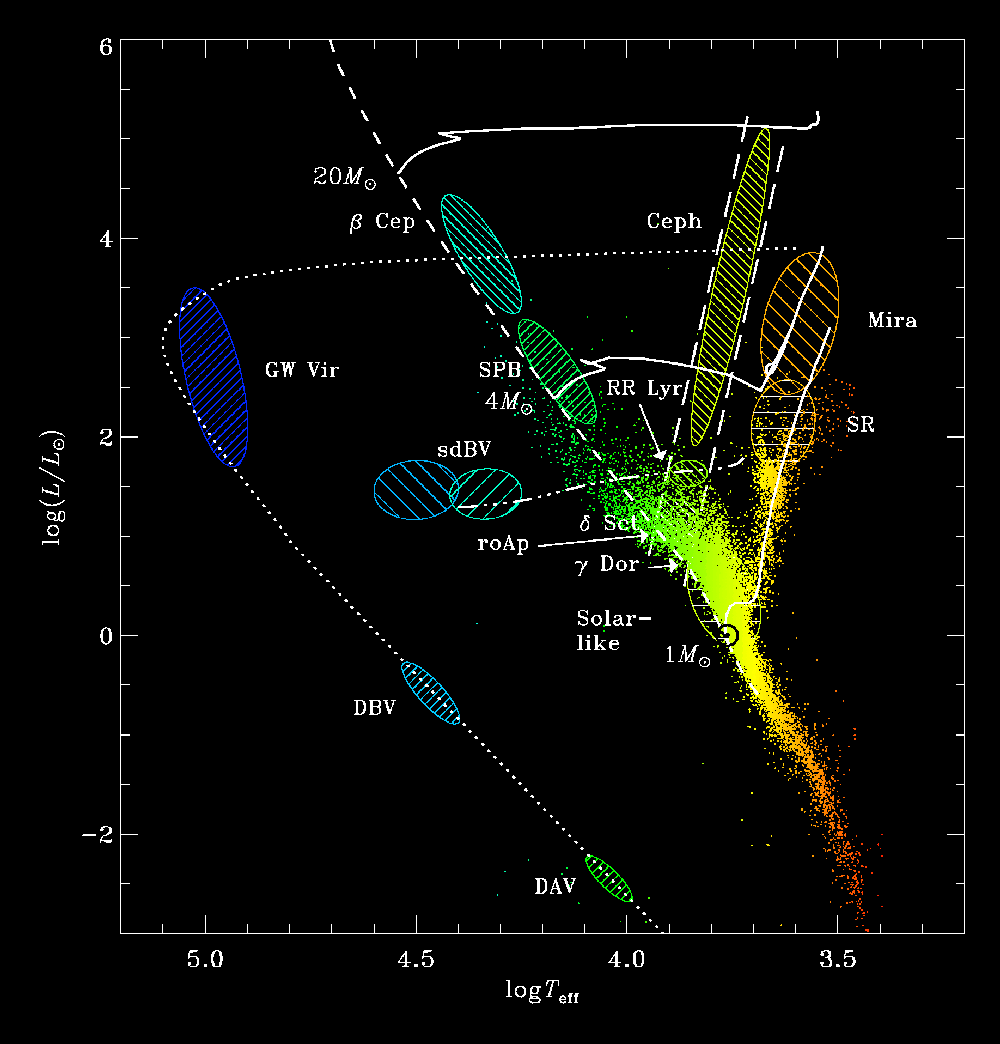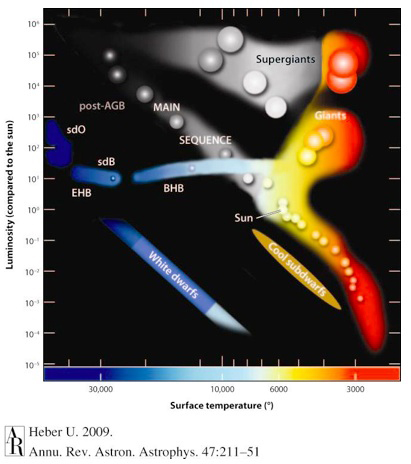 Stellar evolution from Pulsations: Hot Subdwarf Stars
Stellar evolution from Pulsations: Hot Subdwarf Stars
My research focuses on observational studies of pulsating hot subdwarf stars with the aim of providing the basis for their asteroseismic analysis. The physical parameters derived by asteroseismology are then used to discriminate between different evolutionary models which is the utmost goal of this research..
Investigator:
Professor: Maja Vuckovic
Image: Pulsating stars across HR diagram, by Prof. J. Christensen-Dalsgaard
Planets and brown dwarfs in close orbits will interact with their host stars, as soon as they evolve to become red giants. However, the outcome of those interactions is still unclear. Recently, several brown dwarfs have been discovered orbiting hot subdwarf stars (sdB) in very short orbital periods of 0.065 - 0.096 d. Those compact helium stars are the stripped cores of the red giant, which lost their envelopes due to the interaction with a close companion. More than 3% of those stars might have close substellar companions. This shows that such companions can significantly affect late stellar evolution and that sdB binaries are ideal objects to study this influence. Currently more than 30 eclipsing sdB binary systems with cool low-mass companions have been discovered. We are using this unique sample to derive the mass distribution of the companions, constrain the fraction of substellar companions and determine the minimum mass needed to strip the red-giant of its envelope. We are especially interested in testing models that predict hot Jupiter planets as possible companions.
Investigators:
Professors: Maja Vuckovic
At the beginning of the 60´s, different independent groups of theoretical physicists arrived to the same conclusions: all coincided on the characteristics that a new type of object should have, if its low mass was sufficiently low and possessing a temperature that would not allow it to fuse hydrogen in its nucleus in a stable way. Nevertheless it was only around 1995 that these type of objects were confirmed observationally (three groups working independently at the same time) and that these theoretically predicted objects did really exist around us. Since then, the availability of instruments that observe in the near, far and mid range infrared (more adequate for observing sub stellar objects) has enabled a veritable explosion of detections of them, usually with temperatures so low as to resemble those of planets. So, fundamental questions like "which are the physical processes that dominate the formation of these objects, or what are the main atmospheric characteristics of the colder sub stellar objects? await yet a definitive answer. In the Instituto de Física y Astronomía we work on giving an observational answer to these and other questions related to brown dwarfs and isolated objects with planetary mass.
The investigators in this area cover:
Subestellar Objects around Evolved Stars
Investigators:
Professors: Matthias Schreiber - Radostin Kurtev - Nikolaus Vogt - Maja Vuckovic - Amelia Bayo
 Hot subdwarf stars represent several stages in the late evolution of low-mass stars as they have evolved far beyond the main sequence (MS) and lie between the MS and the white-dwarf (WD) sequence (see figure H-R.jpg).
Hot subdwarf stars represent several stages in the late evolution of low-mass stars as they have evolved far beyond the main sequence (MS) and lie between the MS and the white-dwarf (WD) sequence (see figure H-R.jpg).
The booming field of hot subdwarf stars has been enriching our knowledge on very broad and diverse fields of astrophysics, all the way from binary stellar evolution and asteroseismology to planet findings. Hot subdwarfs are directly linked with a number of issues in astrophysics such as the second parameter problem and multiple stellar population puzzles in globular clusters; binary evolution via Roche Lobe Overflow; common envelope evolution; white dwarf mergers and progenitors of SN Ia supernova. On a galactic scale, they seem to be the key for explaining the ultraviolet upturn phenomenon in giant elliptical galaxies and bulges in spiral galaxies.
While these unique stellar laboratories continue to provide remarkable astrophysical findings they still manage to elude us in understanding the most important stellar evolution question, namely, how exactly do they form?
Hot subdwarf stars (spectral type B, and O, shortly sdB and sdO) are extreme horizontal branch stars (EHB) that are low-mass white dwarf (WD) precursors. To date, the precise age and evolutionary history of these stars are unknown. They are core helium burning stars that have exceptionally thin hydrogen envelopes unable to sustain hydrogen shell burning. Therefore, these stars evolve directly to the WD cooling sequence avoiding the asymptotic giant branch (AGB) phase. The mechanism by which they’ve lost their envelopes has been controversial, in particular, how they managed to lose nearly all of their hydrogen at almost exactly the same time as the helium core has attained the minimum mass (∼0.5 M⊙) required for the helium flash to occur?
As a significant fraction of hot subdwarfs are found in binaries various types of close binary interactions are required for their formation, depending on the mass ratio, schemes such as common-envelope ejection (CEE), Roche-lobe overflow (PLOF), and mergers, have been proposed. The fact that they most likely form via binary interactions makes them a valuable testing ground for binary stellar evolution theory.
We are currently involved in several project aiming at deriving the fundamental parameters and backtracing the controversial evolution of hot subdwarfs.
- Astroseismology of hot subdwarfs,
- The influence of close substellar companions on late stellar evolution,
- Orbital analysis of short period subdwarf binaries,
- Detecting and characterizing the substellar objects around EHB stars,
- Orbital period distribution of long period subdwarf binaries, in 2009 we initiated a spectroscopic monitoring survey to further populate the period-eccentricity space, and constrain possible eccentricity-pumping mechanisms
- Irradiation effects in HW Vir-type binaries, we are analysing and modelling the irradiated light of the cool M dwarf secondaries in HW Vir-type binaries in order to derive accurate masses of both components and pin down the evolution of these systems. Combining these results with luminosity and astrometric data from Gaia mission to eliminate outliers will make the final assessment on the masses of the EHB stars.
The remaining questions we are interested in are - why some sdB star pulsate while others do not? - why some close binary systems are fully synchronised while others are not? - are planets, recently reported, around hot subdwarfs real? – if so, do planets play an important role in the formation of sdB stars?
If you are also puzzled by any of these questions drop us a note or come and join us!
Investigators:
Professors Maja Vuckovic
Postdocs: Joris Vos
To date more than thousand exoplanets have been detected in the neighbourhood of the Solar System but the precise mechanisms by which planets are formed are still largely unknown. The situation is particularly worrying for giant planets for which two very different formation theories exist, namely core accretion and gravitational instabilities. Planets are formed in circumstellar discs around young stellar objects and the best places to look for signs of planetary formation are the so called "transition" discs. We study the physics of transition discs and the planet formation process using theoretical models as well as observations with ALMA, SPHERE and sparse aperture masking at the VLT, Gemini/GPI, and the Magellan telescopes. We closely collaborate with the compact binary group (also led by M.R. Schreiber) and are part of the Millennium ALMA Disk nucleus.
Investigators:
Professors: Matthias Schreiber
Postdocs: Claudio Cáceres - Héctor Cánovas
Students: Adam Hardy (PhD) - Daniela Iglesias (PhD)
Former members:
Gisela Romero (Universidad de La Plata, Argentina) - Marianna Orellana (Universidad de La Plata, Argentina)





